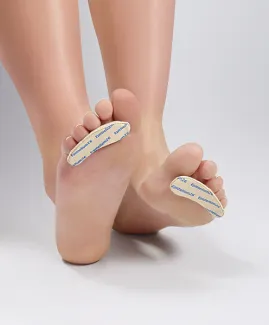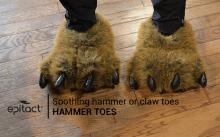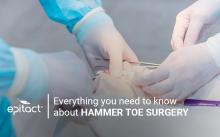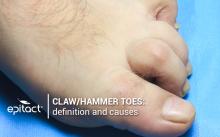
Hammer toes
Hammer, mallet and claw toe cushions for reducing pressure and rubbing on the bent toes.

Free Shipping 
What is a hammer toe?
Hammer toes are frequent toe deformities that affect the joints, more often the four lesser toes. There are three major types of deformities:
- hammer toes affect the middle joint of the toe, which is bent downwards;
- mallet toes affect the joint farthest to the base of the toe, which is bent downwards;
- claw toes affect both joints, which are flexed downwards. The toe resembles an animal claw.
Symptoms of hammer, claw and mallet toes
Hammer toes, claw toes and mallet toes are visible deformities that can cause pain in the joints, toes and ball of the foot. Indeed, bent toes have two major consequences:
- the affected raised toe joint suffers excessive friction and pressure against the shoe. This causes redness and irritation of the skin and progressively lead to the formation of painful corns.
- as the toe no longer lies flat on the ground, it does not support the load it initially did. This load is then carried over to other areas, especially the ball of the foot, which support excessive pressure, characterised by calluses and pain.
Causes of claw toes, hammer and mallet toes
Bent toes have several causes and risk factors. They are usually the result of an abnormal balance of the toes muscles and tendons that normally hold the toe straight. They can also be related to particular foot shapes or deformities like hollow feet and hallux valgus. Or, hammer toes can be hereditary deformities or associated with a rheumatic or neurologic disease or balance disorders. Among the main risk factors for hammer toes, let’s cite inappropriate footwear, namely tight and narrow shoes or high heels!
How to treat bent toes?
First step: prevent and relieve pain by wearing roomier footwear and comfortable hammer toes cushions! If you have corns, some toe protectors also exist to help them disappear. Following a daily foot care routine is also important (smooth dead skin removal, moisturising…).
Second step: correct the deformity by wearing custom-made orthopaedic insoles (in case of an underlying deformity) or toe orthotics. Also, doing some stretching exercises is beneficial for hammer, claw or mallet toes.
Third step: if your joint is stiffened or if the previous treatment did not work, your healthcare provider can recommend you surgery.
The EPITACT® solution for hammer toes relief
To relieve the pain caused by claw toes and corns, EPITACT® has created the hammer toes cushions*. Those protections help to unfold bent toes to limit rubbing and pressure against the shoe and so the formation of corns. They are silicone devices covered with soft, thin and resistant fabric for high comfort. By redistributing the loads under the forefoot, they give back toes their initial function and limit the development of calluses under the ball of the foot.
*This solution is a class I medical device that bears the CE marking under this regulation. Carefully read the instructions before use.
Manufacturer: Millet Innovation. 05/2023
To limit the formation of corns on bent toes, you should regularly apply keratolytic cream.
FALSE! The keratolytic cream destroys the corn: it therefore attacks the consequences but not the causes of corns. If the toes are still flexible, it is possible to extend them to limit their contact with the shoe. But if the deformity is fixed, it is always possible to limit the conflict between the toes and the shoe with a gel pad that distributes pressure.
Some types of shoes favour hammer and claw toes.
TRUE! Too narrow or too small shoes as well as high heels are not recommended for people with hammer, claw or mallet toes. Prefer shoes with a wider toe box to make some room to your toes. More flexible shoes would better fit the foot shape and limit painful pressures.
At an advanced stage, claw or hammer toes are irreversible.
TRUE! At an early stage, the deformity of claw or hammer toes can be corrected (wearing adapted shoes, protections, foot care). However, at an advanced stage, pain and rubbing can be relieved but the deformity won’t disappear. In this case, surgery may be considered.
 Pharmacie
Pharmacie

